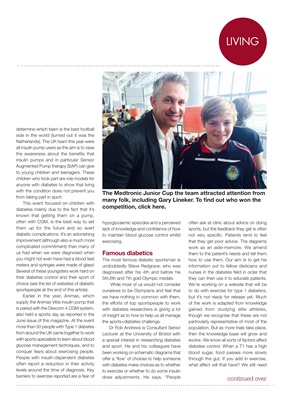
continued over
LIVING
determine which team is the best football
side in the world (turned out it was the
Netherlands). The UK team this year were
all insulin pump users as the aim is to raise
the awareness about the benefits that
insulin pumps and in particular Sensor
Augmented Pump therapy (SAP) can give
to young children and teenagers. These
children who took part are role models for
anyone with diabetes to show that living
with the condition does not prevent you
from taking part in sport.
This event focused on children with
diabetes mainly due to the fact that it's
known that getting them on a pump,
often with CGM, is the best way to set
them up for the future and so avert
diabetic complications. It's an astonishing
improvement (although also a much more
complicated commitment) than many of
us had when we were diagnosed when
you might not even have had a blood test
meters and syringes were made of glass!
Several of these youngsters grow up and
stay true, working hard on their diabetes
control and their sport of choice - see the
list of websites of diabetic sportspeople.
Earlier in the year, Animas, which
supply the Animas Vibe insulin pump that
is paired with the Dexcom 4 CGM system,
also held a sports day as reported in the
June issue of this magazine. At the event
more than 50 people with Type 1 diabetes
from around the UK came together to work
with sports specialists to learn about blood
glucose management techniques, and to
conquer fears about exercising people.
People with insulin-dependent diabetes
often report a reduction in their activity
levels around the time of diagnosis. Key
barriers to exercise reported are a fear of
hypoglycaemic episodes and a perceived
lack of knowledge and confidence of how
to maintain blood glucose control whilst
exercising.
Famous diabetics
The most famous diabetic sportsman is
undoubtedly Steve Redgrave, who was
diagnosed after his 4th and before his
5th,6th and 7th gold Olympic medals.
While most of us would not consider
ourselves to be Olympians and feel that
we have nothing in common with them,
the efforts of top sportspeople to work
with diabetes researchers is giving a lot
of insight as to how to help us all manage
the sports+diabetes challenge.
Dr Rob Andrews is Consultant Senior
Lecturer at the University of Bristol with
a special interest in researching diabetes
and sport. He and his colleagues have
been working on schematic diagrams that
offer a 'flow' of choices to help someone
with diabetes make choices as to whether
to exercise or whether to do some insulin
dose adjustments. He says, "People
often ask at clinic about advice on doing
sports, but the feedback they get is often
not very specific. Patients tend to feel
that they get poor advice. The diagrams
work as an aide-memoire. We amend
them to the patient's needs and tell them
how to use them. Our aim is to get his
information out to fellow dieticians and
nurses in the diabetes field in order that
they can then use it to educate patients.
We're working on a website that will be
to do with exercise for type 1 diabetics,
but it's not ready for release yet. Much
of the work is adapted from knowledge
gained from studying elite athletes,
though we recognise that these are not
particularly representative of most of the
population. But as more trials take place,
then the knowledge base will grow and
evolve. We know all sorts of factors affect
diabetes control. When a T1 has a high
blood sugar, food passes more slowly
through the gut. If you add in exercise,
what affect will that have? We still need
The Medtronic Junior Cup the team attracted attention from
many folk, including Gary Lineker. To find out who won the
competition, click here.